Tomb of Dracula
#20
May 1974
"The coming of Doctor
Sun"
|
|
Story - Marv Wolfman
Art - Gene Colan
Inks - Tom Palmer
Colours - Glynis Wein
Cover - Gil Kane
|
| |
|
| |
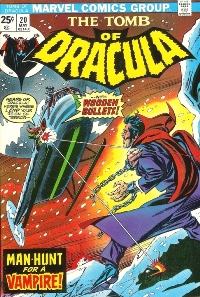 |
|
Following one of the worst
covers of the series, Tomb of Dracula #20
hit the newsagent stands in May 1974 with what
must rank as a truly classic Marvel Comics cover. With Rachel
van Helsing safe on board, Frank Drake hunts
Dracula in the Transsylvanian Alps with a
helicopter and firing wooden bullets. However,
the vampire count manages to escape once more,
although he is then hurled to the ground by a
strong gust of wind and knocked unconscious. Back
on the Irish coast, the vampire Brand finally
meets Dr Sun, who reveals himself to be a human
brain sheathed in a life-supporting containment
device.
When Dracula wakes up, he
finds that he is a prisoner bound with a
combination of chains and garlic - and learns
that he has fallen into the hands of Dr Sun. It
is revealed that the successful capturing of
Dracula was accomplished thanks to the help of
Clifford Graves, whom we all believed to be dead
since Tomb of Dracula #10.
Slightly reminiscent of Dr Frankenstein, Dr Sun
had Graves restored to life after finding his
body.
|
|
| |
| Nearby, Drake and van Helsing
discover a manmade passage in the side of a mountain, and
they land the helicopter and search the area. Meanwhile,
Dracula has slipped free and attacks Clifford Graves. The
two vampire hunters appear on the scene, but before long,
Dracula, van Helsing, and Drake find themselves trapped
in an immobility beam when Dr Sun appears and tells
Dracula that he intends to take over control of all
vampires.
Tomb of
Dracula #20 was a highlight in the series,
with a fast-paced story which brings together several
layers of plot which Wolfman had diligently set up and
weaved together, a rich tapestry of interlocking events
and characters - not the least of course the suspense
surrounding the figure of Dr Sun, who once more could
have come straight from one of those delightfully obscure
yet atmospheric horror movies of the 1930s to 1950s
period - in spite of Wolfman's pronounced lack of
interest in the genre's films.
Tomb of
Dracula #20 was also the first issue in which Marv
Wolfman put forward in a detailed way the changes he
wanted to make to the original plot as set out in Tomb
of Dracula #1 -6. To this end, he has Rachel van Helsing
tell Drake about how her grandfather, Abraham Van
Helsing, believed he had destroyed Dracula (i.e. in the
events that Bram Stoker's novel was supposedly based on)
only to have the vampire lord return years later and kill
him. Later, when Rachel was nine years old, her parents
were also killed - before her eyes - by Dracula,
with Rachel herself being saved by Quincy Harker.
This is Wolfman's clear-cut disposal of the original plot
developed in the first issues of Tomb of Dracula.
|
| |
|
| |
Tomb
of Dracula #21
June 1974
"Deathknell!"
|
|
Story - Marv
Wolfman
Art - Gene Colan
Inks - Tom Palmer
Colours - Tom Palmer
Cover - Gil Kane
|
|
| |
|
| |
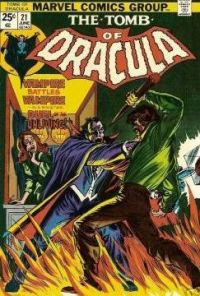 |
|
Confronting his captives, Dr
Sun reveals his origin: a prominent Chinese
scientist, his brain was removed by a team of
surgeons and transferred into an anti-matter
receptacle connected to a vast computer bank as a
form of government punishment - not realizing
that rather than making the computers more
powerful this actually gave Dr Sun control over
the computers. However, he
requires vast quantities of blood to survive.
Using a kind of mind-transfer machine, Dr Sun
will copy Dracula's knowledge and memories into
Brand, whom he intends to make the new lord of
vampires under his control. He
sets up a fight between Dracula and his vampire
slave Brand, who hurls Dracula into a panel of
electronics, causing an explosion and Dracula'a
apparent demise. With Dracula defeated,
Brand attempts to turn onto Dr Sun, who has
prepared for such an occassion and destroys him.
He then sets his Transylvanian base to self
destruct and teleports to safety. Frank
Drake and Rachel Van Helsing make their escape,
thinking Dracula has finally been destroyed -
unaware of the bat flying away from Dr Sun's
exploding base... |
| |
|
|
|
| Featuring
highly atmospheric artwork by Gene Colan, Tomb of
Dracula #21 marks the erstwhile end of the
confrontation between Dracula and Dr Sun. At the same
time, back in London, Quincy Harker cannot convince Blade
to join his group of vampire hunters as Blade leaves on
his own in order to continue his search for the vampire
who killed his mother, ending another subplot of
Wolfman's storyline. By this time, Tomb of Dracula was
a big success for Marvel. It had established a loyal
readership, with the number of sold copies still rising
month after month. Apart from trying to use this
popularity to push other characters and titles which were
not as successful, such as the Frankenstein Monster,
Marvel was eager to cash in even more on Dracula. This
led to the first "Giant-Size" Dracula in June
1974, although the first issue was titled Giant-Size
Chillers "featuring the Curse of Dracula".
|
| |
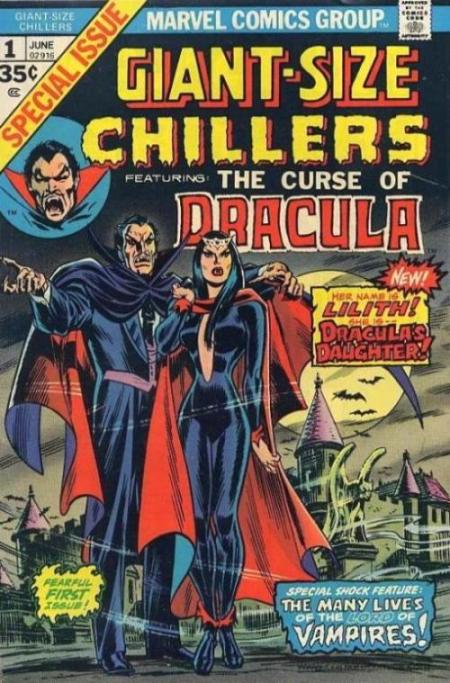 |
|
Written by Marv Wolfman and
pencilled by Gene Colan, readers were given an
"extra" that month in the proven
quality formula (although a substantial part of
the 96 pages featured two completely detached
reprint vampire stories from the 1950s). The
story introduced Lilith, the daughter of Dracula,
and as such was a matter of taste. The plot was,
however, carried over to Tomb of Dracula #22,
published the same month, through a brief mention
of the fight between Lilith and Quincy Harker. Giant-Size
Chillers would become Giant-Size Dracula
as of issue #2 (September 1974). One might
assume that Wolfman and Colan just didn't have
the time to produce additional quality material
on top of their regular work for Tomb of
Dracula, but whatever the reason, plotting
and pencilling passed on to others after Giant-Size
Chillers.
|
|
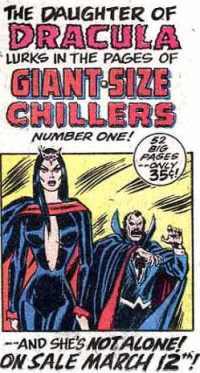 |
|
| |
| The
results were nowhere near to what Wolfman and Colan had
to offer, and things got worse issue after issue until
the whole thing was mercifully called off after issue #5
in June 1975. |
| |
|
| |
Tomb
of Dracula #22
July 1974
"In death do we
join!"
|
|
Story - Marv
Wolfman
Art - Gene Colan
Inks - Tom Palmer
Colours - Linda Lessman
Cover -
|
|
| |
|
| |
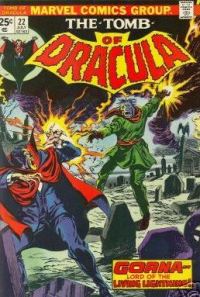 |
|
With so many threads
of the plot of the past few issues neatly
tied up, Tomb of Dracula #22
presents a more or less self-contained
story which finds Dracula in a village in
Moldavia (at the time part of the Soviet
Union) following his flight from the
Transylvanian Alps. A violent man by the
name of Gorna has returned to haunt his
wife after his mysterious death which, it
turns out, was caused by the attack of a
vampire. What follows is
another vampire against vampire clash
(the third in the series so far, this
time fittingly set in the village
graveyard), during which Dracula is
forced to realize that he cannot
overwhelm Gorna at first, even though he
is the lord of all vampires. Eventually,
a second showdown between the two does
end with Dracula's victory and the
destruction of Gorna, but this slack in
Dracula's powers will present a major
plot element in upcoming issues -
typically for Wolfman, even a
self-contained single issue storyline
contains tags which serve a bigger
picture. In many ways, Tomb of
Dracula #22 is like a brief breather
on a rollercoaster ride before taking the
next hair-raising plunge.
|
|
|
| |
| Back in London, Quincy Harker learns
from Rachel van Helsing that their comrade Taj has
disappeared, leaving England to return to his native
India. |
| |
| Whilst this story -
entertainingly told as it was - would certainly
not rank as one of the classic issues of Tomb
Of Dracula, Gene Colan's artwork was now in
a league of its own, with an atmospheric density
which just drew readers in. Always a master of
panel arrangements, Colan also knew how to throw
an extraordinary splash page at you, and in Tomb
Of Dracula #22 pages 17 and 18 even featured
a doublespread which illustrates nicely the force
and dynamics the artwork had taken on by this
time. With Wolfman and Colan teaming up so
elegantly, this was a comic book which almost
felt as though there was sound and motion to it. [click for larger image]
|
|
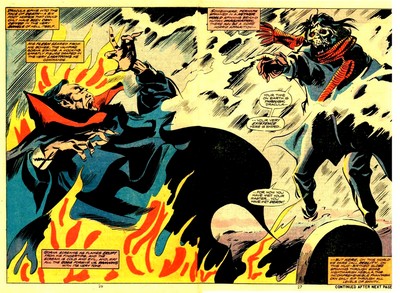 |
|
| |
|
| |
Tomb
of Dracula #23
August 1974
"Shadows in the
night!"
continued from Giant-Size
Chillers #1
|
|
Story - Marv
Wolfman
Art - Gene Colan
Inks - Tom Palmer
Colours - Petra Goldberg
Cover - Gil Kane / Tom Palmer
|
|
| |
|
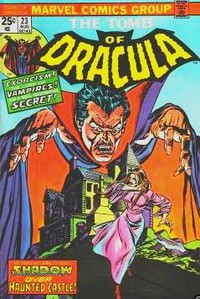 |
|
Taking up
another element from the storyline of Giant-Size
Chillers #1 Wolfman elaborates on
Dracula's plot to see his plans through
by securing influence over members of
Parliament, turning them into willful
servants of his cause. Apart from this
background plot, Tomb
of Dracula #23 simply presents a
basic ghost story. Dracula has obtained
possession of Dunwick castle, inhabited
by a terrified young woman named Shiela
Whittier. Dracula, whom Wolfman has shown
to be intrigued by supernatural events
before, begins to investigate and soon
discovers that the castle is haunted by
Shiela's father. He drives away the
ghost and saves the girl's life out of a
growing sense of emotional attachment.
Elsewhere in India,
Taj returns home to his family, and back
in London, strangely enough, one of
Dracula's mind controlled servants from
the House of Lords somehow breaks free
from his hypnotic spell (another pointer
by Wolfman for the attentive reader that
Dracula is somehow losing his vampiric
powers).
|
|
|
| |
| In an attempt to avoid an all too
repetitive plot of Dracula being continuosly on the run,
Wolfman also seized the chance to introduce a new main
female character not forming part of the gang of
vampire-hunters in the person of Shiela Whittier. |
| |
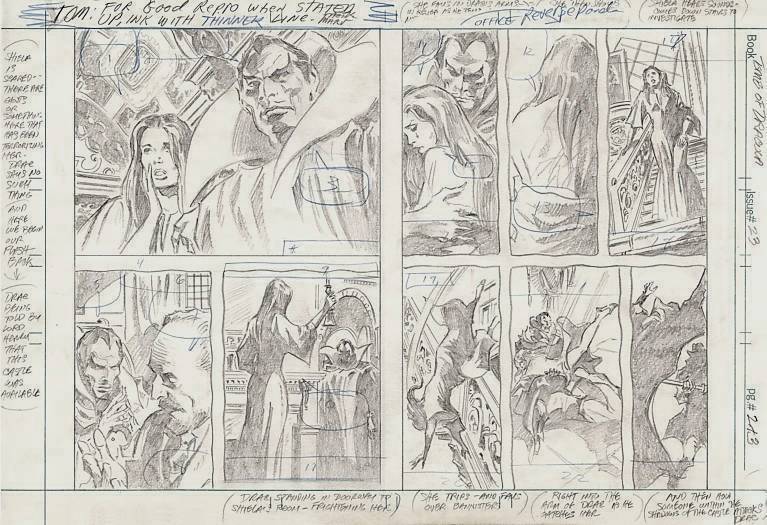
|
| |
In the 1970s, it was a
regular working procedure that the original pencils of an
artist would be worked on directly by the inker.
"Surviving" original pencil work by Gene Colan
for Tomb of Dracula is thus rather rare and
usually only occured when an individual page went missing
on the way to the inker or major corrections needed to be
worked in. This example, depicting pages 2 and 3 of Tomb
of Dracula #23 is a special case as Colan drew two
pages on one actual sheet of art paper - supposedly as a
measure advocated by Marvel to alleviate the effects of
the sharply rising paper prices at the time. The result
was original pencil art in the (highly unusual) size of
the actual end product which proved too awkward to ink
and had Tom Palmer lightbox enlarged versions and working
on those (at the handwritten suggestion of Marv Wolfman),
thus preserving the pencil work for posterity and
providing an interesting insight into the working
procedures involved in the creation of Tomb of
Dracula.
|
| |
|
| |
Tomb
of Dracula #24
September 1974
"A night for the
living... a morning for the dead!"
|
|
Story - Marv
Wolfman
Art - Gene Colan
Inks - Tom Palmer
Colours - Tom Palmer
Cover - Gil Kane
|
|
| |
|
| |
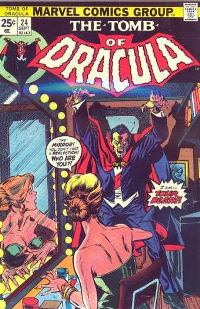 |
|
Three years
have passed since Frank Drake was
prevented from jumping from a
bridge by Rachel Van Helsing and
Taj, and Frank and Rachel now
stand on that very same bridge
and reflect upon times past and
present and ponder their future,
now that they believe Dracula to
be dead (in real time, only two
and a half years had passed since
Tomb of Dracula #3 had
gone on sale). At the same
time, in Castle Dunwick, Shiela
Whittier is wondering about
Dracula's whereabouts and reaches
the personal conclusion that she
cannot believe that he is a
vampire - whilst the reader
witnesses Dracula attacking yet
another victim. Drama also
unfolds in London that night as
Blade rescues his girlfriend
Saffron from a vampire.
Back in her apartment,
Blade learns from one of her
colleagues at work, Trudy, about
a mysterious stranger with fangs
from which the girl ran to the
safety of Saffron's home after
repelling him with a cross. Hearing this
story, Blade seriously begins to
doubt the news from Quincy
Harker that Dracula is
dead.
|
|
|
|
| |
| In Jajpur, Taj returns to the home of
his wife and learns from her that their son is dying,
whilst back in London Blade tracks down the vampire that
attacked Trudy, but the following fight ends with the
escape of the vampire. Blade is unaware of the vampire's
true identity as Dracula remained in bat form throughout
the struggle. Elsewhere, Frank Drake
kisses Rachel Van Helsing goodbye, promising to return
but tells her that he must first find out just who he is. After two
issues without the gang of vampire-hunters playing a
major role, the individuals forming the group are once
again in the spotlight. Wolfman has them going off in
various personal directions: Blade is in full swing,
while Frank Drake and Taj both seem to set sails for new
horizons.
|
| |
|
| |
WHERE TO READ IT
The original issues of Tomb of
Dracula #19-24 can be found fairly easily, but the
overall classic status of the series is reflected by
higher prices in comparison to other Bronze Age comic
books. In a collectable (VFN/very fine) condition these
issues will command around $32.00, with issues #22 and
#23 going for $20.00 (as per the 2013/14 Overstreet Price
Guide), and are still widely available in this grade.
Copies intended for reading more than collecting (in
VG/very good to G/good condition) sell for between $10.00
and $5.00.
Alternatively, reading Tomb of
Dracula #19-24 in collected form is a viable
alternative as Marvel has reprinted this early material
in several forms. The most Dracula you can get for your
money comes, no doubt, in the form of Essential Tomb
of Dracula volume 1 (ISBN 0-7851-0920-X), which
collects issues #1-#25 (as well as Werewolf By Night
#15 and Giant-Size Chillers #1); it was first
published in December 2003 for a cover price $16.99. The
only compromise here is cheap quality paper (actually
making the Essentials close cousins of the originals in
that respect) and loss of colour as the reprints are all
black and white; whilst some feel that this actually
accentuates the wonderful Gene Colan artwork, it does
take away an original element of the series.
A far more luxurious collected
edition is Marvel's Tomb of Dracula Omnibus
volume 1; this hardcover and oversize edition assembles
issues #1-31 plus Werewolf By Night #15, Giant-Size
Chillers #1 and Giant-Size Dracula #2-4.
Published in November 2008 it has, however, been out of
print for quite a while, and although it can still be
found in places, it is quite common to see outright silly
prices asked even for second-hand copies.
In July 2010, Marvel started to
publish a series of trade paperback colour collections of
Tomb of Dracula; volume 2 features issues #13-23
and volume 3 collects issues #24-31 and
Giant-Size Dracula #2-4. They are currently by far
the most economical way (at a cover price of $24.99, they
can be found for $19.99) to read these issues of the
series in colour.
|
| |
|
| |
continue with
TOMB
OF DRACULA # 25 - 30
|
| |
